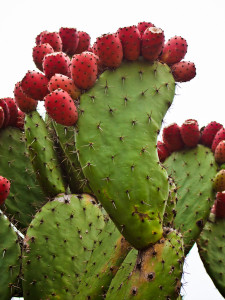Nopal is a type of cactus, typical of Mexico.
Contents
Uses
- Prickly pear cactus is used for type 2 diabetes, high cholesterol, obesity, alcohol hangover, colitis, diarrhea, and benign prostatic hypertrophy (BPH). It is also used to fight viral infections.
- In foods, the prickly pear juice is used in jellies and candies.
Benefits
- Diabetes. Single doses of prickly pear cactus can decrease blood sugar levels by 17% to 46% in some people. However, it is not known if extended daily use can consistently lower blood sugar levels. The broiled stems of one prickly pear cactus species seem to lower blood sugar levels in people who have type 2 diabetes. However, raw or crude stems of this species do not seem to work. Other prickly pear cactus species don’t seem to work either.
- Hangover. Taking prickly pear cactus before drinking alcohol might reduce some symptoms of hangover the next day. It seems to significantly reduce nausea, anorexia, and dry mouth. However, it does not seem to reduce other hangover symptoms such as headache, dizziness, diarrhea, or soreness.
- Enlarged prostate. Men with an enlarged prostate often feel their bladder is full, and they experience frequent, strong urges to urinate. Developing evidence suggests that taking powdered prickly pear cactus flowers may reduce these symptoms.
- Inherited high cholesterol. Early research shows that taking edible pulp of prickly pear cactus daily for 4 weeks, while following a diet, reduces total and low-density lipoprotein (LDL or “bad”) cholesterol levels in people with inherited high cholesterol.
- High blood cholesterol. Early research shows that taking edible pulp of prickly pear cactus daily, while following a diet, can reduce total cholesterol, low-density lipoprotein (LDL or “bad”) cholesterol, and triglyceride levels in people with high cholesterol. High-density lipoprotein (HDL or “good”) cholesterol levels do not seem to be affected.
- Metabolic syndrome. Early research suggests that taking a specific product containing dehydrated leaves of prickly pear cactus (NeOpuntia) daily for 6 weeks does not affect fat levels in the blood in women with metabolic syndrome.
Cautions
Pregnancy and breast-feeding: There is not enough reliable information about the safety of taking prickly pear cactus if you are pregnant or breast-feeding. Stay on the safe side and avoid use.
Diabetes: Prickly pear cactus might lower blood sugar levels in people with diabetes. Watch for signs of low blood sugar (hypoglycemia) and monitor your blood sugar carefully if you have diabetes and use prickly pear cactus.
Surgery: Prickly pear cactus might affect blood sugar levels, making blood sugar control difficult during and after surgery. Stop using prickly pear cactus at least 2 weeks before a scheduled surgery.
Interactions
- Chlorpropamide (Diabinese) interacts with PRICKLY PEAR CACTUS
Chlorpropamide (Diabinese) is used to decrease blood sugar in people with diabetes. Prickly pear cactus might also decrease blood sugar. Taking prickly pear cactus along with chlorpropamide (Diabinese) might cause your blood sugar to go too low. Monitor your blood sugar closely. The dose of your chlorpropamide (Diabinese) might need to be changed. - Glyburide (Diabeta, Micronase) interacts with PRICKLY PEAR CACTUS
Glyburide (Diabeta, Micronase) is used to decrease blood sugar in people with diabetes. Prickly pear cactus might also decrease blood sugar. Taking prickly pear cactus along with glyburide (Diabeta, Micronase) might cause your blood sugar to go too low. Monitor your blood sugar closely. The dose of glyburide (Diabeta, Micronase) might need to be changed. - Medications for diabetes (Antidiabetes drugs) interacts with PRICKLY PEAR CACTUS
Prickly pear cactus can decrease blood sugar in people with type 2 diabetes. Diabetes medications are also used to lower blood sugar. Taking prickly pear cactus along with diabetes medications might cause your blood sugar to go too low. Monitor your blood sugar closely. The dose of your diabetes medication might need to be changed.Some medications used for diabetes include glimepiride (Amaryl), insulin, pioglitazone (Actos), rosiglitazone (Avandia), glipizide (Glucotrol), tolbutamide (Orinase), and others. - Metformin (Glucophage) interacts with PRICKLY PEAR CACTUS
Metformin (Glucophage) is used to decrease blood sugar in people with diabetes. Prickly pear cactus might also decrease blood sugar. Taking prickly pear cactus along with metformin (Glucophage) might cause your blood sugar to go too low. Monitor your blood sugar closely. The dose of your metformin (Glucophage) might need to be changed.
Other names
Barbary-fig Cactus, Cactus Flowers, Cactus Fruit, Cactus Pear Fruit, Figue d’Inde, Figuier de Barbarie, Fruit du Cactus, Fruit de l’Oponce, Gracemere-Pear, Indian-fig Prickly Pear Cactus, Indien-Figue, Nopal, Nopal Cactus, Nopales, Nopol, OPI, Oponce, Opuntia, Opuntia cardona, Opuntia ficus, Opuntia ficus-indica, Opuntia Fruit, Opuntia fuliginosa, Opuntia hyptiacantha, Opuntia lasciacantha, Opuntia macrocentra, Opuntia megacantha, Opuntia puberula, Opuntia streptacantha, Opuntia velutina, Opuntia violacea, Prickly Pear, Tuna Cardona, Westwood-Pear
References

